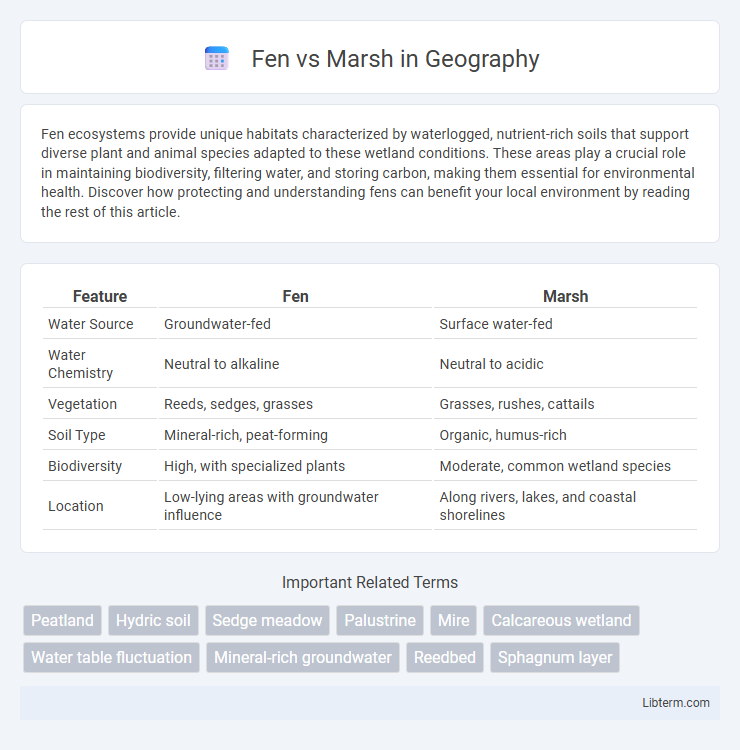Fen ecosystems provide unique habitats characterized by waterlogged, nutrient-rich soils that support diverse plant and animal species adapted to these wetland conditions. These areas play a crucial role in maintaining biodiversity, filtering water, and storing carbon, making them essential for environmental health. Discover how protecting and understanding fens can benefit your local environment by reading the rest of this article.
Table of Comparison
| Feature | Fen | Marsh |
|---|---|---|
| Water Source | Groundwater-fed | Surface water-fed |
| Water Chemistry | Neutral to alkaline | Neutral to acidic |
| Vegetation | Reeds, sedges, grasses | Grasses, rushes, cattails |
| Soil Type | Mineral-rich, peat-forming | Organic, humus-rich |
| Biodiversity | High, with specialized plants | Moderate, common wetland species |
| Location | Low-lying areas with groundwater influence | Along rivers, lakes, and coastal shorelines |
Introduction to Wetlands: Fen vs Marsh
Fens and marshes are both types of wetlands distinguished by their unique hydrology and vegetation. Fens are peat-forming wetlands fed primarily by groundwater, characterized by alkaline, nutrient-rich conditions supporting sedges, grasses, and wildflowers. Marshes, in contrast, are dominated by herbaceous plants such as cattails and reeds, typically located in nutrient-rich, frequently flooded areas with standing or slow-moving water.
Defining Fens and Marshes
Fens are peat-forming wetlands fed by mineral-rich surface or groundwater, characterized by alkaline conditions that support diverse plant species such as sedges, grasses, and wildflowers. Marshes, in contrast, are freshwater wetlands dominated by herbaceous plants like cattails and reeds, typically found in nutrient-rich, neutral to slightly acidic waters with frequent flooding. Both ecosystems provide critical habitat for wildlife and play vital roles in water filtration and carbon storage.
Key Differences Between Fens and Marshes
Fens are peat-forming wetlands that receive nutrients from groundwater, making them less acidic and more alkaline compared to marshes, which primarily accumulate nutrients from surface water and tend to be more neutral or slightly acidic. Marshes are dominated by herbaceous plants like cattails and sedges, whereas fens support a diverse range of sedges, grasses, and wildflowers adapted to nutrient-rich conditions. The hydrology of fens is groundwater-fed with slow, steady water flow, while marshes experience more variable water levels influenced by surface water inflow and outflow.
Water Sources and Hydrology
Fens are groundwater-fed wetlands characterized by slow-moving, mineral-rich water that supports diverse plant communities adapted to alkaline conditions. Marshes primarily receive water from surface runoff, precipitation, or tidal influx, resulting in nutrient-rich, often acidic or neutral waters that sustain emergent herbaceous vegetation. Hydrologically, fens exhibit stable water tables influenced by consistent groundwater discharge, whereas marshes experience more variable water levels driven by fluctuating surface water inputs.
Soil Composition and Nutrient Levels
Fens exhibit mineral-rich soils with higher pH levels and abundant calcium and magnesium, supporting diverse plant species adapted to nutrient-rich environments. Marshes contain organic-rich, waterlogged soils with lower pH and higher concentrations of nitrogen and phosphorus, favoring vegetation tolerant of more acidic, nutrient-variable conditions. Soil composition differences influence distinct nutrient cycling processes and ecological functions within these wetland types.
Characteristic Vegetation in Fens and Marshes
Fens feature sedges, grasses, and brown mosses adapted to alkaline, nutrient-rich, and groundwater-fed conditions. Marshes predominantly support herbaceous plants such as cattails, reeds, and bulrushes thriving in nutrient-rich, periodically or permanently flooded environments with neutral to acidic pH. The distinct hydrology and nutrient availability drive the unique vegetation communities in fens and marshes, influencing biodiversity and ecosystem function.
Wildlife and Biodiversity Comparison
Fens support a diverse array of plant species including sedges, grasses, and wildflowers, providing habitats for rare insects, amphibians, and birds adapted to nutrient-rich, alkaline conditions. Marshes, characterized by standing water and emergent vegetation like cattails and reeds, offer essential breeding grounds for waterfowl, fish, and invertebrates, promoting high species diversity in freshwater ecosystems. The contrasting hydrology and nutrient availability between fens and marshes result in distinct wildlife communities, with fens favoring specialized, nutrient-sensitive species while marshes support a broader range of aquatic and semi-aquatic organisms.
Ecological Importance of Fens and Marshes
Fens and marshes play a crucial role in maintaining biodiversity by providing unique habitats for diverse plant and animal species, including rare orchids in fens and numerous amphibians in marshes. These wetlands act as natural water filters, improving water quality by trapping sediments and absorbing pollutants, while also serving as vital carbon sinks that mitigate climate change effects. Their hydrological functions support groundwater recharge and flood control, making fens and marshes essential for ecosystem resilience and environmental health.
Threats and Conservation Challenges
Fens face threats from nutrient enrichment, drainage, and invasive species that disrupt their unique hydrology, while marshes are primarily endangered by urban development, pollution, and altered water regimes. Both wetland types suffer from habitat fragmentation, leading to biodiversity loss and reduced ecosystem services. Conservation efforts must prioritize hydrological restoration, invasive species control, and protection from land conversion to ensure the resilience of fen and marsh ecosystems.
Restoration and Protection Strategies
Fen restoration strategies emphasize re-establishing natural hydrology by blocking drainage channels and re-wetting peat soils to revive native plant communities and enhance carbon sequestration. Marsh protection focuses on maintaining fluctuating water levels and preserving native emergent vegetation to support diverse wildlife habitats and prevent invasive species intrusion. Both ecosystems benefit from buffer zone creation and careful nutrient management to sustain biodiversity and ecosystem resilience.
Fen Infographic

 libterm.com
libterm.com